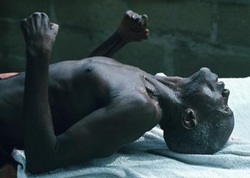Stages and Symptoms

The disease usually infects a host through open wounds, where
the bacterial agent then uses surface proteins as a vehicle of infection.
Once at this stage, the first stages of Tetanus are present through Lockjaw or Risus Sardonicus. These cases cause major stiffness and
spasms within the victim's jaw and facial areas. If gone untreated, the disease will most likely spread throughout the body, causing it to stiffen, and even move erratically. As such stiffness occurs, the victim may experience an extreme difficulty in breathing.
the bacterial agent then uses surface proteins as a vehicle of infection.
Once at this stage, the first stages of Tetanus are present through Lockjaw or Risus Sardonicus. These cases cause major stiffness and
spasms within the victim's jaw and facial areas. If gone untreated, the disease will most likely spread throughout the body, causing it to stiffen, and even move erratically. As such stiffness occurs, the victim may experience an extreme difficulty in breathing.
There are four clasifications of these symptoms. The first of which is general, affecting the skeletal muscles, this being the most common and most severe. The next is localized, being that spasms and pain are centralized around the wound of which the bacteria entered. The third is cephalic, affecting the victim's facial muscles, hencewise lockjaw is formed and another form of the condition, Trismus, can occur. The last is neonatal, similar to general symptoms, but only present within infants less than a month of age. It is highly advisable that when the first signs of tetanus occur that medical treatment be administered immediately. Although the risk of such is minimal, death can occur from the disease, most likely through lack of circulation or asphyxiation.
